Exercise 8.2 class 9 || class 9 quadrilaterals exercise 8.2 || class 9 maths chapter 8 exercise 8.2 || ncert solutions for class 9 chapter quadrilaterals exercise 8.2 || exercise 8.2 class 9 maths || class 9 exercise 8.2 || exercise 8.2 class 9 solutions || quadrilaterals class 9 exercise 8.2
Explore clear, step-by-step solutions for Class 9 Maths Chapter 8, Exercise 8.2, which deepens students’ understanding of the properties and theorems related to quadrilaterals, especially parallelograms. This exercise focuses on applying previously established results—such as opposite sides and angles of a parallelogram being equal, diagonals bisecting each other, and conditions for a quadrilateral to be a parallelogram. Through a variety of conceptual and proof-based problems, learners reinforce their logical thinking and ability to justify geometrical relationships using deductive reasoning. Exercise 8.2 strengthens the students’ grasp on geometric proof writing and lays a solid base for future studies in coordinate geometry, constructions, and reasoning-based problem solving.

exercise 8.2 class 9 || class 9 quadrilaterals exercise 8.2 || class 9 maths chapter 8 exercise 8.2 || ncert solutions for class 9 chapter quadrilaterals exercise 8.2 || exercise 8.2 class 9 maths || class 9 exercise 8.2 || exercise 8.2 class 9 solutions || quadrilaterals class 9 exercise 8.2
Exercise 8.2
(i) \( \mathrm{SR} \| \mathrm{AC} \) and \( \mathrm{SR}=\frac{1}{2} \mathrm{AC} \)
(ii) \( \mathrm{PQ}=\mathrm{SR} \)
(iii) \( \operatorname{PQRS} \) is a parallelogram.
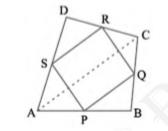
Midpoint theorem: In a triangle, the line segment joining the mid-points of any two sides of the triangle is parallel to the third side and is half of it \( \mathrm{SR} \| \mathrm{AC} \) and \( \mathrm{SR}=\frac{1}{2} \mathrm{AC} \ldots(1)\) [By mid-point theorem]
(ii) In \( \triangle \mathrm{ABC}, \mathrm{P} \) and Q are mid-points of sides AB and BC respectively. Therefore, by using mid-point theorem
\(\mathrm{PQ} \| \mathrm{AC} \text { and } \mathrm{PQ}=\frac{1}{2} \mathrm{AC}\ldots(2)\)
Using equations (1) and (2), we obtain
\(\mathrm{PQ} \| \mathrm{SR} \text { and } \mathrm{PQ}=\mathrm{SR}\ldots(3)\)
\(\mathrm{PQ}=\mathrm{SR}\)
(iii) From equation (3), we obtained
\( P Q \| S R \) and
\(\mathrm{PQ}=\mathrm{SR}\)
Clearly, one pair of opposite sides of quadrilateral PQRS is parallel and equal
Hence, PQRS is a parallelogram
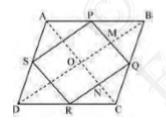
To Prove: PQRS is a rectangle.
For that, we need to prove that, \( \mathrm{PQ}=\mathrm{RS}, \mathrm{PS}=\mathrm{QR} \) and also, that angles of PQRS are all right angles.
Proof:
We start by proving the equality of sides of quadrilateral \( \operatorname{PQRS} \)
In \( \triangle A B C, P \) and \( Q \) are the mid-points of sides \( A B \) and \( B C \) respectively,
The Midpoint Theorem states that the segment joining two sides of a triangle at the midpoints
of those sides is parallel to the third side and is half the length of the third side.
\( \therefore \) From the mid-point theorem, \( \mathrm{PQ} \| A C \& \)
\(\mathrm{PQ}=\frac{1}{2} \mathrm{AC}\ldots(1)\)
Also, R and S are the mid-points of CD and AD respectively
\( \therefore \) From the mid-point theorem,
\(RS || AC\)
\( \& R S=\frac{1}{2} \mathrm{AC} \ldots(2)\)
Therefore,
From equations (1) and (2), we obtain \( P Q \| R S \) and \( P Q=R S \)
Since in quadrilateral \(PQRS \), one pair of opposite sides is equal and parallel to each other
So it is a parallelogram.
Let the diagonals of rhombus ABCD intersect each other at point O
In quadrilateral \(OMQN\),
\(MQ \| ON (\text{Because} PQ \| AC)\)
\(QN|| OM (\text{Because} QR || BD)\)
Therefore,
\(OMQN\) is a parallelogram
\(\angle \mathrm{MQN}=\angle \mathrm{NOM}\)
\(\angle \mathrm{PQR}=\angle \mathrm{NOM}\)
However, \( NOM =900 \) (Diagonals of a rhombus are perpendicular to each other)
So, \( \mathrm{PQR}=900 \)
Clearly, \(PQRS\) is a parallelogram having one of its interior angles as \(900\)
Hence, \(PQRS\) is a rectangle
Hence, Proved.
exercise 8.2 class 9 || class 9 quadrilaterals exercise 8.2 || class 9 maths chapter 8 exercise 8.2 || ncert solutions for class 9 chapter quadrilaterals exercise 8.2 || exercise 8.2 class 9 maths || class 9 exercise 8.2 || exercise 8.2 class 9 solutions || quadrilaterals class 9 exercise 8.2
In \( \triangle \mathrm{ABC} \),
P and Q are the mid-points of AB and BC respectively
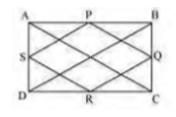
To Prove: PQRS is a rhombus.
Proof:
The Midpoint Theorem states that the segment joining two sides of a triangle at the midpoints of those sides is parallel to the third side and is half the length of the third side.
\( \mathrm{PQ} \| \mathrm{AC} \) and \( \mathrm{PQ}=\mathrm{AC} \) (Mid-point theorem) \(\ldots(1)\)
Similarly, in \( \triangle \mathrm{ADC} \),
\( \mathrm{SR} \| \mathrm{AC} \) and \( \mathrm{SR}=\frac{1}{2} \mathrm{AC} \) (Mid-point theorem) \(\ldots(2)\)
Clearly,
\( P Q \| S R \) and \( P Q=\frac{1}{2} S R \)
Since in quadrilateral PQRS, one pair of opposite sides is equal and parallel to each other, it is a parallelogram
\(PS \| QR\) and \(PS = QR\) (Opposite sides of parallelogram) \(\ldots(3)\)
In \( \triangle B C D, Q \) and \( R \) are the mid-points of side \( B C \) and \( C D \) respectively. \( \mathrm{QR} \| \mathrm{BD} \) and \( \mathrm{QR}=\frac{1}{2} \mathrm{BD} \) (Mid-point theorem) \(\ldots(4)\)
However, the diagonals of a rectangle are equal.
\( \mathrm{AC}=\mathrm{BD} \ldots(5) \)
By using equation (1), (2), (3), (4), and (5), we obtain
\(\mathrm{PQ}=\mathrm{QR}=\mathrm{SR}=\mathrm{PS}\)
Now, as all sides of the rhombus are equal.
Hence, PQRS is a rhombus.
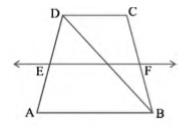
By converse of mid-point theorem, we know that a line drawn through the mid-point of any side of a triangle and parallel to another side, bisects the third side
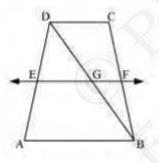
In \( \triangle \mathrm{ABD} \),
\( \mathrm{EF} \| \mathrm{AB} \) and E is the mid-point of AD
Therefore,
G will be the mid-point of DB
\( \mathrm{EF} \| \mathrm{AB} \) and
\( \mathrm{AB} \| \mathrm{CD} \)
\( \mathrm{EF} \| \mathrm{CD} \) (Two lines parallel to the same line are parallel to each other)
In \( \triangle B C D \),
\( \mathrm{GF} \| \mathrm{CD} \) and
G is the mid-point of line BD. Therefore, by using converse of mid-point theorem, F is the mid-point of BC
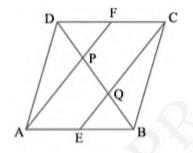
ABCD is a parallelogram.
So, \( \mathrm{AB} \| \mathrm{CD} \)
\( \Rightarrow \mathrm{AE} \| \mathrm{FC} \)
Also \( \mathrm{AB}=\mathrm{CD} \)
(Opposite sides of parallelogram ABCD )
\( \Rightarrow \mathrm{AE}=\mathrm{FC} \)
(Since E and F are midpoints of AB and CD )
In quadrilateral AECF, one pair of opposite sides are equal and parallel.
\( \therefore \) AECF is a parallelogram.
Then,
\(AE \| FC\)
Again,
\(\mathrm{AB}=\mathrm{CD}(\text { Opposite sides of parallelogram } A B C D)\)
\(\mathrm{AB}=\mathrm{CD}\)
\(\mathrm{AE}=\mathrm{FC}(\mathrm{E} \text { and } \mathrm{F} \text { are mid-points of side } \mathrm{AB} \text { and } C D)\)
In quadrilateral AECF, one pair of opposite sides is parallel and equal to each other
Therefore, AECF is a parallelogram
\(AF|| EC\) (Opposite sides of a parallelogram)
In \( \triangle \mathrm{DQC} \),
F is the mid-point of side DC and FP \( \| \) CQ
Therefore, by using the converse of mid-point theorem, it can be said that \( P \) is the mid-point of DQ
\(\mathrm{DP}=\mathrm{PQ}\ldots(1)\)
\(\frac{1}{2} \mathrm{AB}=\frac{1}{2} \mathrm{CD}\)
Similarly,
In \( \triangle \mathrm{APB} \),
\( E \) is the mid-point of side \( A B \) and \( E Q \| A P \)
Therefore, by using the converse of mid-point theorem, it can be said that \(Q\) is the mid-point of \(PB\)
\(\mathrm{PQ}=\mathrm{QB}\ldots(2)\)
From equations (1) and (2),
\(D P=P Q=B Q\)
Hence, the line segments \(AF\) and \(EC\) trisect the diagonal \(BD \).
Let \( A B C D \) is a quadrilateral in which \( P, Q, R \), and \( S \) are the mid-points of sides \( A B, B C, C D \), and \( D A \) respectively. Join \( P Q, Q R, R S, S P \), and \( B D \).
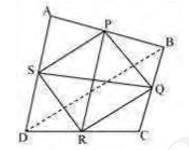
In \( \triangle \mathrm{ABD}, \mathrm{S} \) and P are the mid-points of AD and AB respectively. Therefore, by using mid-point theorem:
\( \mathrm{SP} \| \mathrm{BD} \) and \( \mathrm{SP}=\frac{1}{2} \mathrm{BD} \ldots(1)\)
Similarly, in \( \triangle \mathrm{BCD} \),
\( \mathrm{QR} \| \mathrm{BD} \) and \( \mathrm{QR}=\frac{1}{2} \mathrm{BD} \ldots(2)\)
From equations (1) and (2), we obtain
\( \mathrm{SP} \| \mathrm{QR} \) and \( \mathrm{SP}=\mathrm{QR} \)
In quadrilateral \(SPQR\), one pair of opposite sides is equal and parallel to each other
Therefore, \(SPQR\) is a parallelogram.
We know that diagonals of a parallelogram bisect each other
Hence, \(PR\) and \(QS\) bisect each other.
(i) \(D\) is the mid-point of \(AC\)
(ii) \( \mathrm{MD} \perp \mathrm{AC} \)
(iii) \( \mathrm{CM}=\mathrm{MA}=\frac{1}{2} \mathrm{AB} \)
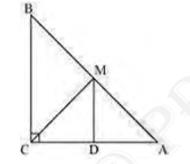
Given that: M is the mid-point of \( A B \) and \( \mathrm{MD} \| \mathrm{BC} \)
Therefore,
The Midpoint Theorem states that the segment joining two sides of a triangle at the midpoints of those sides is parallel to the third side and is half the length of the third side.
D is the mid-point of AC (By converse of mid-point theorem)
(ii) As \( \mathrm{DM} \| \mathrm{CB} \) and AC is a transversal line for them
Therefore, \( \angle \mathrm{MDC}+\angle \mathrm{DCB}=180^{\circ} \) (Co-interior angles)
\(\angle \mathrm{MDC}+90^{\circ}=180^{\circ}\)
\(\angle \mathrm{MDC}=90^{\circ}\)
MD is perpendicular to AC
(iii) Join MC
In \( \triangle \mathrm{AMD} \) and \( \Delta \mathrm{CMD} \),
\( \mathrm{AD}=\mathrm{CD} \) ( D is the mid-point of side AC\( ) \)
\( \angle \mathrm{ADM}=\angle \mathrm{CDM}\left(\right. \) Each \( \left.90^{\circ}\right) \)
\( \mathrm{DM}=\mathrm{DM} \) (Common)
Two sides and included angle (SAS) Definition: Triangles are congruent if any pair of corresponding sides and their included angles are equal in both triangles.
\( \Delta \mathrm{AMD} \cong \Delta \mathrm{CMD}( \) By SAS congruence rule \( ) \)
Therefore,
\( \mathrm{AM}=\mathrm{CM}(\mathrm{By} \) CPCT \( ) \)
However,
\( A M=\frac{1}{2} A B \) ( \( M \) is the mid-point of \( A B \) )
Therefore,
\(\mathrm{CM}=\mathrm{AM}=\frac{1}{2} \mathrm{AB}\)

